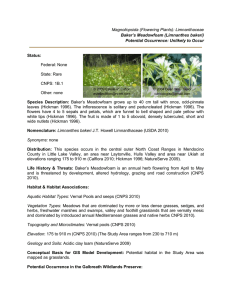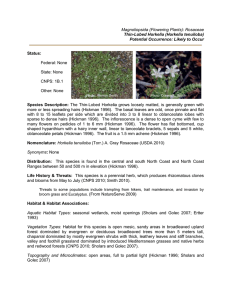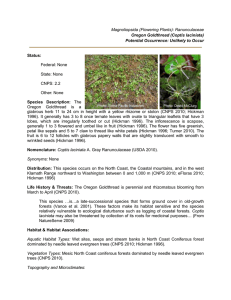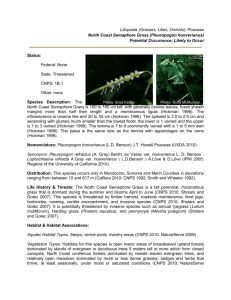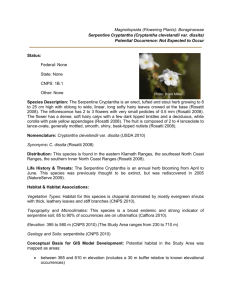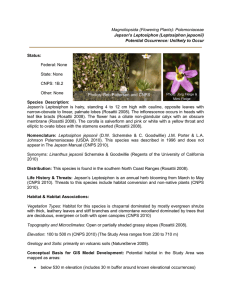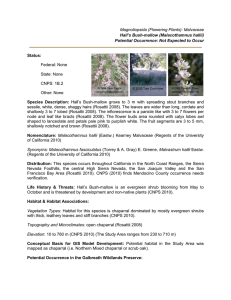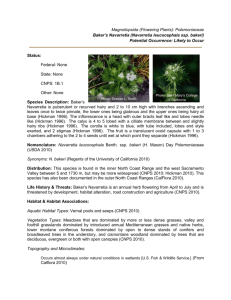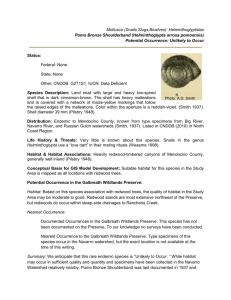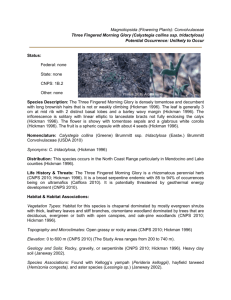TRRO Text
advertisement
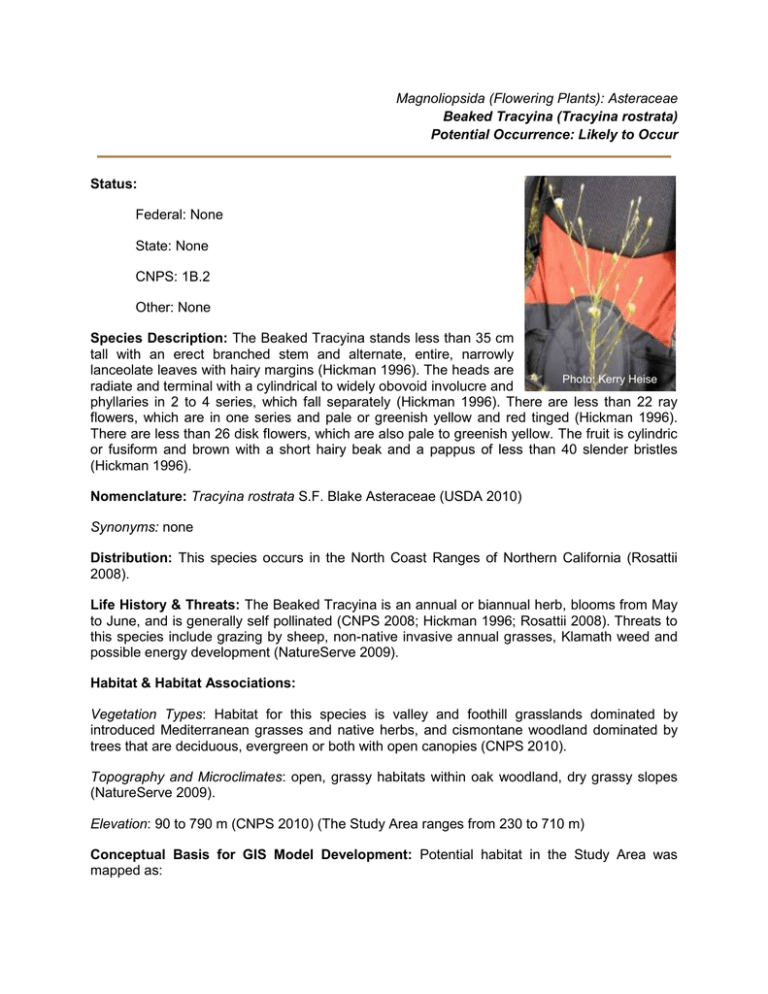
Magnoliopsida (Flowering Plants): Asteraceae Beaked Tracyina (Tracyina rostrata) Potential Occurrence: Likely to Occur Status: Federal: None State: None CNPS: 1B.2 Other: None Species Description: The Beaked Tracyina stands less than 35 cm tall with an erect branched stem and alternate, entire, narrowly lanceolate leaves with hairy margins (Hickman 1996). The heads are Photo: Kerry Heise radiate and terminal with a cylindrical to widely obovoid involucre and phyllaries in 2 to 4 series, which fall separately (Hickman 1996). There are less than 22 ray flowers, which are in one series and pale or greenish yellow and red tinged (Hickman 1996). There are less than 26 disk flowers, which are also pale to greenish yellow. The fruit is cylindric or fusiform and brown with a short hairy beak and a pappus of less than 40 slender bristles (Hickman 1996). Nomenclature: Tracyina rostrata S.F. Blake Asteraceae (USDA 2010) Synonyms: none Distribution: This species occurs in the North Coast Ranges of Northern California (Rosattii 2008). Life History & Threats: The Beaked Tracyina is an annual or biannual herb, blooms from May to June, and is generally self pollinated (CNPS 2008; Hickman 1996; Rosattii 2008). Threats to this species include grazing by sheep, non-native invasive annual grasses, Klamath weed and possible energy development (NatureServe 2009). Habitat & Habitat Associations: Vegetation Types: Habitat for this species is valley and foothill grasslands dominated by introduced Mediterranean grasses and native herbs, and cismontane woodland dominated by trees that are deciduous, evergreen or both with open canopies (CNPS 2010). Topography and Microclimates: open, grassy habitats within oak woodland, dry grassy slopes (NatureServe 2009). Elevation: 90 to 790 m (CNPS 2010) (The Study Area ranges from 230 to 710 m) Conceptual Basis for GIS Model Development: Potential habitat in the Study Area was mapped as: grasslands cismontane woodland (i.e., mixed, mixed montane or single dominant hardwoods with canopy cover < 40%) We additionally mapped possible best potential habitat in the areas identified above as: dry slopes (>8˚ slopes facing S, SE, or SW) Potential Occurrence in the Galbreath Wildlands Preserve: Habitat: Habitat for this species, grassland and cismontane woodlands, occur commonly in the central portion of the Galbreath Wildlands Preserve. Approximately half of this potential habitat occurs on the dry slopes preferred by Beaked Tracyina. The map may overestimate suitable habitat because grasslands and some areas of the cismontane understory are dominated by non-native annual grasses, which are a threat to this species. Despite the occurrence of nonnatives, an understory of native grasslands are common on the Preserve, and we estimate habitat quality as moderate to good quality. Nearest Occurrence: Documented Occurrences in Galbreath Wildlands Preserve: Previous species list for the Galbreath Wildlands Preserve did not document this species (SSU Field Station and Nature Preserves 2010). Nearest Occurrence to Galbreath Wildlands Preserve: This species is known from areas north (Humboldt County), south (one occurrence in Sonoma County) and east (6 occurrences in Mendocino County) of the Preserve (Calflora 2010). Distances among reported occurrences are commonly 10 miles or more. The nearest occurrence to the Preserve is approximately 6 miles to the southeast in Big Foot Mountain Quad at the top of the Middle Russian River watershed (Calflora 2010). Summary: We anticipate this species to be “Likely to Occur” because the species occurs nearby (relative to distances among other documented occurrences), and habitat is moderate to good quality and relatively abundant in the Preserve. References Calflora. 2010. Information on California plants for education, research and conservation.<http://www.calflora.org/>. Accessed 2010 Jul 2. California Native Plant Society (CNPS). 2010. Inventory of Rare and Endangered Plants. Online edition, v7-10b. <http://www.cnps.org/inventory>. Accessed 2010 Jul 2. Heise K. 2006. Traycina rostrata. <http://calphotos.berkeley.edu/cgi-bin/img_query?reltaxon=contains&where-taxon=Tracyina+rostrata>. Accessed 2010 Jul 2. Hickman JC editor. 1996. The Jepson Manual Higher Plants of California. 3rd printing. London: University of California Press, Ltd. 354 p. NatureServe. 2009. NatureServe Explorer: An online encyclopedia of life [web application]. Version 7.1. <http://www.natureserve.org/explorer>. Accessed 2010 Jul 2. Rosatti, T. 2008. DRAFT Second Edition of the Jepson Manual: Vascular plants of California. <http://ucjeps.berkeley.edu/tjm2/review/treatments/brassicaceae_all.html#10626>. Accessed 2010 Jul 2. SSU Field Stations and Nature Preserves. 2010. Galbreath Wildlands Preserve Vascular Plant List. Compiled by CNPS Milo Baker Chapter, Linden Schneider, and others. <http://www.sonoma.edu/preserves/docs/galbreath_vascular_plants.pdf>. Accessed 2010 Jun. United States Department of Agriculture (USDA). 2010. PLANTS Profile. <http://plants.usda.gov/java/profile?symbol=TRRO>. Accessed 2010 Jul 20. Species Account Description: Linden Schneider
